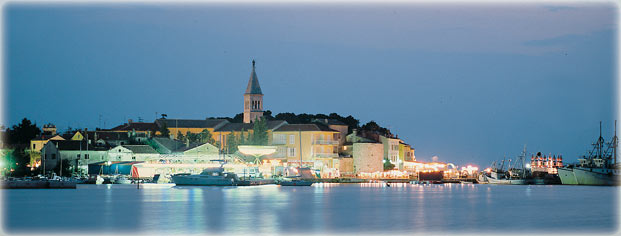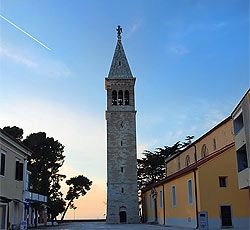-
City harbour Mandrač (Novigrad, Istria)
City harbour, the popular Mandrač, in history was the centre of Novigrad’s life as a small fishing village. Once a central place of economic activities, Mandrač maintained in part, the status of a fishing port, thereby continuing the old tradition, which connects Novigrad and its people to the sea. Therefore, Mandrač is one of the most important symbols of Novigrad, which gives the city a recognizable Mediterranean charm. -
City walls Novigrad (Istria)
The historic center of the city was once entirely surrounded by the city walls, the course of which remains noticeable also today, as a symbol of the city. In the 13th century, with the fall of the city and under the rule of Venice, the walls were rebuilt on the remains of Late Antique fortifications. The walls were renewed repeatedly. An older square tower stands next to the former city gate, while the round towers originate from the Renaissance period. Thanks to its walls, the city of Novigrad is a member of the international association WTFC.
City walls Novigrad Info -
Novigrad Lapidary (Novigrad, Istria)
The Museum collection exhibits the variety of the architectural components of the stone monuments from the Antique and Medieval Age. Mauritian ciborium from the Early Medieval Age,one of the rare examples of the early Caroline Art, presents the most important part of the lapidary. In 1994 the monuments were completely repaired and conserved in order to mantain them. -
Bell tower (Novigrad, Istria)
The freestanding bell tower next to the parish church of St. Pelagius and St. Maximilian was built in 1883 and patterned after the bell tower of St. Mark's in Venice. On the tower’s pyramidal spire dominates the statue of St. Pelagius, the city’s patron saint, who was placed there in 1913. The statue is made of wood and covered with a bronze metal sheet. During the summer months, visitors can climb to the top of the bell tower from which there is a beautiful view of the Novigrad’s Riviera.
Bell tower Novigrad Info -
Church of St. Pelagius and St. Maximilian (Novigrad, Istria)
The parish church of St. Pelagius and St. Maximilian (a cathedral until 1828) is a basilica with three naves, which received its original form in the Early Christianity. Traces of earlier periods are visible along the northern longitudinal wall, where Early Christian window frames were discovered in 1972. The interior of the church is dominated by a Baroque altar and a raised, deep choir, under which an (Early) Romanesque crypt is located, unique of its kind in Istria and one of few in Croatia.
Church of St. Pelagius and St. Maximilian Info
Novigrad, Cestovní průvodce pro dovolenou v Novigradu, Istrie
Novigrad
 Novigrad proslavilo množství památek, které dokládají bohatou historii tohoto města. Nenechte si ujít zdejší kolekci 93 kamenných předmětů z dob antiky a a novověku, kostel sv. Pelagia a sv. Maksima (bazilika si zachovala původní podobu z křesťanské éry, kdy byla novigradská diecéze vybudovaná), palác Rigo (barokní dům patricijské rodiny Rigů postavený v roce 1760), Belvedere ze 16. století, městské hradby ze 13. století, románský kostel sv. Agáty z 9. století, zámek Dajla (venkovská vila – klášter) a mnoho dalších historických památek. Novigrad je také místem, kde se v letním období konají nejrůznější slavnosti. Mezi ty nejznámější patří: Kulturní léto Novigrad (zábava a kultura, termín 10.06. – 31.08.), Gnam Gnam festival (gastronomický festival, který se koná 9. července), Novigradské hudební noci (14. – 15.07.), Rybářská noc a oslava sv. Pelagia (26.08. – 28.08.). Během pobytu v Novigradu máte ideální příležitost prozkoumat také jeho okolí: malé ostrůvky, historická města a nedaleký přírodní park. Milovníci sportu a aktivní dovolené si zde mohou zahrát nohejbal, basketbal, tenis a plážový volejbal. Oblast je skvělá i pro projížďky na kole a samozřejmě různé vodní sporty.
Novigrad proslavilo množství památek, které dokládají bohatou historii tohoto města. Nenechte si ujít zdejší kolekci 93 kamenných předmětů z dob antiky a a novověku, kostel sv. Pelagia a sv. Maksima (bazilika si zachovala původní podobu z křesťanské éry, kdy byla novigradská diecéze vybudovaná), palác Rigo (barokní dům patricijské rodiny Rigů postavený v roce 1760), Belvedere ze 16. století, městské hradby ze 13. století, románský kostel sv. Agáty z 9. století, zámek Dajla (venkovská vila – klášter) a mnoho dalších historických památek. Novigrad je také místem, kde se v letním období konají nejrůznější slavnosti. Mezi ty nejznámější patří: Kulturní léto Novigrad (zábava a kultura, termín 10.06. – 31.08.), Gnam Gnam festival (gastronomický festival, který se koná 9. července), Novigradské hudební noci (14. – 15.07.), Rybářská noc a oslava sv. Pelagia (26.08. – 28.08.). Během pobytu v Novigradu máte ideální příležitost prozkoumat také jeho okolí: malé ostrůvky, historická města a nedaleký přírodní park. Milovníci sportu a aktivní dovolené si zde mohou zahrát nohejbal, basketbal, tenis a plážový volejbal. Oblast je skvělá i pro projížďky na kole a samozřejmě různé vodní sporty. 



